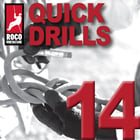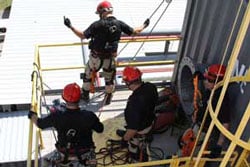 Many rescue scenes (and teams) are plagued by confusion because of too much communication. And, if you have three people assigned to do a task, each one will have his or her own idea of how it should be done, where the system should be anchored, etc. Many times the discussion that follows eats up valuable time and slows the team’s ability to get rescuers into a location and get hands on the patient.
Many rescue scenes (and teams) are plagued by confusion because of too much communication. And, if you have three people assigned to do a task, each one will have his or her own idea of how it should be done, where the system should be anchored, etc. Many times the discussion that follows eats up valuable time and slows the team’s ability to get rescuers into a location and get hands on the patient.
This drill is designed to instill confidence among team members, to ensure that rescuers understand their responsibilities at the scene and to help rescuers understand that there are different ways to accomplish the same goals safely. It also helps in getting rescuers to look at the entire scene and understand where their assignment fits in the big picture. It encourages team members to anticipate and solve their own problems.
1) Assign a safety officer/drill manager.
2) Locate a simple vertical simulated space to enter or a balcony or roof edge. The goal is to lower the rescuer into an area.
3) Safety officer/drill manager describes the event to the team and assigns task(s) to each team member.
4) Instructs the team that they are not allowed to speak unless a dangerous condition is observed.
5) Instructs team members to gather the equipment necessary to accomplish their job or task. (Remember No Talking!)
6) Once team members have the needed equipment, move them to location and let them start rigging to get rescuer into the space or over the edge.
7) Once rescuer is lowered into area, leave systems rigged and debrief entire team on the rigging, the order that it was done and what could be done differently.
The difficulty of this drill can be increased by doing an entire simulated rescue or adding SCBA/SAR to the station requirements. You will find that a lot of unnecessary chatter that occurs at rescues will be reduced. It will allow you to see who truly understands “where and how” each component of a rescue system fits in the overall operation. It also encourages rescuers to look at the big picture and anticipate what, where and when they will need to have their assignments completed without waiting for direct supervision.
Next in this series: Quick Drill #14 - Knots Challenge (Advanced)


 Oxygen-Depleted Atmospheric Hazards in Confined Spaces
Oxygen-Depleted Atmospheric Hazards in Confined Spaces My experiences in the altitude chamber were educational and potentially lifesaving if I were ever exposed to a low oxygen environment. By having experienced my subtle symptoms multiple times, perhaps I would recognize them in a lower than normal oxygen environment and be able to take action to rescue myself. However, the environment that I was exposed to was probably in the range of 12% oxygen by volume give or take. In lower concentrations, say below 10%, the onset of impaired judgment would be so rapid that I would have little chance to recognize and react on my own behalf. In extremely low concentrations of 0-8%, there is little chance for anyone to take self-rescue actions. More than likely, the individual will pass out after only one or two gasping breaths. And, most importantly, my experiences were in a controlled environment with highly trained observers and emergency personnel standing by. This is not always the case during confined space entry operations.
My experiences in the altitude chamber were educational and potentially lifesaving if I were ever exposed to a low oxygen environment. By having experienced my subtle symptoms multiple times, perhaps I would recognize them in a lower than normal oxygen environment and be able to take action to rescue myself. However, the environment that I was exposed to was probably in the range of 12% oxygen by volume give or take. In lower concentrations, say below 10%, the onset of impaired judgment would be so rapid that I would have little chance to recognize and react on my own behalf. In extremely low concentrations of 0-8%, there is little chance for anyone to take self-rescue actions. More than likely, the individual will pass out after only one or two gasping breaths. And, most importantly, my experiences were in a controlled environment with highly trained observers and emergency personnel standing by. This is not always the case during confined space entry operations.


 Human beings are born with an innate fear of heights. This is natural, and quite protective. I’m certainly afraid of heights, and I still get butterflies. It’s just that I’ve learned how to get those butterflies to fly in formation, so I can then function just fine at height. The day I climb atop a wind turbine tower or get that first peek over the edge of some serious exposure, and I don’t get that familiar feeling, that’s my sign to hang up my harness and ride the keyboard full time. This feeling is our not-too-subtle reminder that we do not have wings…and it is a healthy reminder!
Human beings are born with an innate fear of heights. This is natural, and quite protective. I’m certainly afraid of heights, and I still get butterflies. It’s just that I’ve learned how to get those butterflies to fly in formation, so I can then function just fine at height. The day I climb atop a wind turbine tower or get that first peek over the edge of some serious exposure, and I don’t get that familiar feeling, that’s my sign to hang up my harness and ride the keyboard full time. This feeling is our not-too-subtle reminder that we do not have wings…and it is a healthy reminder! So, how do we learn what our best role as a rescuer may be? Here’s one way. Practice as a team in simulated rescues that are scenario driven and mimic the types of rescues that your team may be summoned to perform. It is during these practice sessions that you will discover your strengths and your weaknesses. It is important for ALL team members to honestly critique each other as well as themselves to help determine the best way to fill the different roles on the team.
So, how do we learn what our best role as a rescuer may be? Here’s one way. Practice as a team in simulated rescues that are scenario driven and mimic the types of rescues that your team may be summoned to perform. It is during these practice sessions that you will discover your strengths and your weaknesses. It is important for ALL team members to honestly critique each other as well as themselves to help determine the best way to fill the different roles on the team. All teams have a spectrum of performers, whether it’s a football team, a production assembly line or a team of cooks and chefs in a large restaurant. The same holds true for a rescue team. Some of the factors that affect performance may be physical. Let’s face it, our 5’4” 150-pound “Hole Rat” can pass through tight portals and operate in congested confined spaces easier than most 6’ 6” 280-pounders. Sometimes it’s mechanical aptitude. We see it all the time in training rescuers. Some folks have a natural mechanical aptitude and can understand and build rescue systems as if it were second nature, while others struggle to get it right on a consistent basis.
All teams have a spectrum of performers, whether it’s a football team, a production assembly line or a team of cooks and chefs in a large restaurant. The same holds true for a rescue team. Some of the factors that affect performance may be physical. Let’s face it, our 5’4” 150-pound “Hole Rat” can pass through tight portals and operate in congested confined spaces easier than most 6’ 6” 280-pounders. Sometimes it’s mechanical aptitude. We see it all the time in training rescuers. Some folks have a natural mechanical aptitude and can understand and build rescue systems as if it were second nature, while others struggle to get it right on a consistent basis. And, yes, a pronounced fear of height that may inhibit a rescuer’s ability to perform effectively at height is yet another factor to consider. Other things include leadership qualities, attention to detail, general physical strength, comfort with breathing air systems, the presence or lack of claustrophobia and the list goes on. The only way to realize and understand these abilities and limitations is to practice as a team – and practice often – while staying attuned to these individual abilities and limits. Understand them and use them to your advantage in determining who is the best fit for the various team member roles on any given rescue effort. And please, please do not take it personally. Again, we all have our pride and want to shine; however, we all can shine as a team! And the best way to shine as a team is to understand, as best we can, where each member best fits and can contribute most.
And, yes, a pronounced fear of height that may inhibit a rescuer’s ability to perform effectively at height is yet another factor to consider. Other things include leadership qualities, attention to detail, general physical strength, comfort with breathing air systems, the presence or lack of claustrophobia and the list goes on. The only way to realize and understand these abilities and limitations is to practice as a team – and practice often – while staying attuned to these individual abilities and limits. Understand them and use them to your advantage in determining who is the best fit for the various team member roles on any given rescue effort. And please, please do not take it personally. Again, we all have our pride and want to shine; however, we all can shine as a team! And the best way to shine as a team is to understand, as best we can, where each member best fits and can contribute most. Guest Eddie Chapa gives an interesting inside look into the world of technical rescue for offshore operations and the complications that are faced under such limited conditions.
Guest Eddie Chapa gives an interesting inside look into the world of technical rescue for offshore operations and the complications that are faced under such limited conditions. From the basics of First Aid/CPR to Basic Life Support for Prehospital Providers, Roco now offers medical training from our professional instructors and experienced emergency responders. This training is designed to provide hands-on instruction for those requiring these lifesaving skills as part of their job – particularly those who work in industrial environments. Students will be taught the critical skills necessary to provide basic first aid for medical, environmental and traumatic injuries.
From the basics of First Aid/CPR to Basic Life Support for Prehospital Providers, Roco now offers medical training from our professional instructors and experienced emergency responders. This training is designed to provide hands-on instruction for those requiring these lifesaving skills as part of their job – particularly those who work in industrial environments. Students will be taught the critical skills necessary to provide basic first aid for medical, environmental and traumatic injuries.


